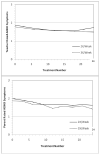EEG neurofeedback for ADHD: double-blind sham-controlled randomized pilot feasibility trial
- PMID: 22617866
- PMCID: PMC3939717
- DOI: 10.1177/1087054712446173
EEG neurofeedback for ADHD: double-blind sham-controlled randomized pilot feasibility trial
Abstract
Objective: Preparing for a definitive randomized clinical trial (RCT) of neurofeedback (NF) for ADHD, this pilot trial explored feasibility of a double-blind, sham-controlled design and adherence/palatability/relative effect of two versus three treatments/week.
Method: Unmedicated 6- to 12-year-olds with Diagnostic and Statistical Manual of Mental Disorders (4th ed.; DSM-IV) ADHD were randomized to active NF versus sham-NF and to 2X versus 3X/week treatment frequency. Frequency switch was allowed after Treatment 24.
Results: In two school years, 39 participants were recruited and 34 (87%) completed all 40 treatments. Child/parent guesses about assigned treatment were no better than chance. At Treatment 24, 38% chose 2X/week and 62% chose 3X/week. Both active NF and sham yielded large pre-post improvement on parent ratings but NF no more than sham.
Conclusion: Blinding appears to work, and sham does not prevent recruitment/retention. Treatment frequency of 3X/week seems preferred over 2X/week and was as effective. A large double-blind RCT is feasible and necessary to test specific NF effectiveness.
Keywords: ADHD; adolescent; neurofeedback.
Figures




References
-
- Cohen J. Statistical Power Analysis for the Behavioral Sciences. 2 ed Lawrence Earlbaum Associates; Hillsdale, NJ: 1988.
-
- Arnold LE. Contemporary Diagnosis and Management of ADHD. 3 ed Handbooks in Health Care Co; Newton, PA: 2004.
-
- Michelson D, Allen AJ, Busner J, Casat C, Dunn D, Kratochvil C, et al. Once-daily atomoxetine treatment for children and adolescents with attention deficit hyperactivity disorder: a randomized, placebo-controlled study. American Journal of Psychiatry. 2002;159:1896. - PubMed
-
- Swanson J, Kraemer H, Hinshaw S, Arnold L, Conners C, Abikoff H, et al. Clinical Relevance of the Primary Findings of the MTA: Success Rates Based on Severity of ADHD and ODD Symptoms at the End of Treatment. Journal of the American Academy of Child and Adolescent Psychiatry. 2001;40:168–179. - PubMed
-
- Kamiya J. Conscious control of brain waves. Psychology Today. 1968:57–60.
Publication types
MeSH terms
Grants and funding
LinkOut - more resources
Full Text Sources
Medical

